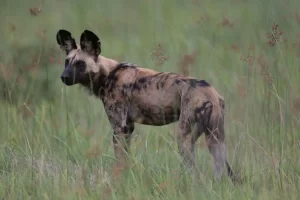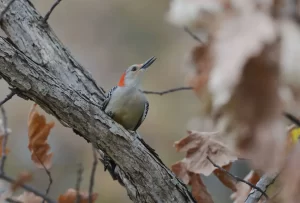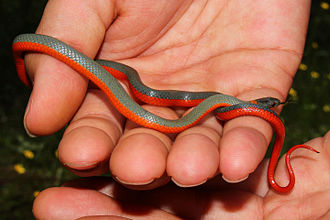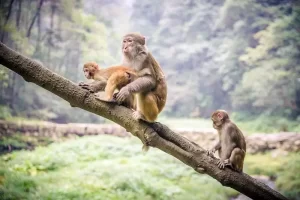The African wild dog is the largest indigenous canid in Africa and one of the most threatened mammals in the world. The fur of African wild dogs consists entirely of stiff bristle-hairs with no underfur. They gradually lose their fur as they age, and older specimens become almost naked. Fur color varies geographically, with northeastern African specimens tending to be predominantly black with small white and yellow patches, while southern African ones are more brightly colored, sporting a mix of brown, black and white coats.

AFRICAN WILD DOG
Their muzzle is usually black, gradually shading into brown on the cheeks and forehead. A black line extends up the forehead, turning blackish-brown on the back of the ears. A few specimens sport a brown teardrop-shaped mark below the eyes. The back of the head and neck are either brown or yellow. A white patch occasionally occurs behind the forelegs, with some specimens having completely white forelegs, chests, and throats.
The tail is usually white at the tip, black in the middle and brown at the base. Some specimens lack the white tip entirely or may have black fur below the white tip. These coat patterns can be asymmetrical, with the left side of the body often having different markings from that of the right. Read the full article, by Pritish Kumar Halder, in which he discussed the most threatened mammals in the world.
Distribution
African wild dogs are native to sub-Saharan Africa. The majority of the species’ population occurs in Southern Africa and southern East Africa.

Distribution – AFRICAN WILD DOG
More specifically in countries such as Botswana, Namibia, Zimbabwe, Angola, Benin, Burkina Faso, Niger, Central African Republic, Chad, Malawi, Mozambique, Senegal, South Africa, South Sudan, Sudan, Ethiopia, Kenya, Tanzania, and Zambia. African wild dogs are mostly found in savanna, and arid zones, open plains, shrubland, and semi-desert, generally avoiding forested areas.
This preference is likely linked to their hunting habits, which require open areas that do not obstruct vision or impede pursuit. Nevertheless, they will travel through the scrub, woodland and montane areas in pursuit of prey. Forest-dwelling populations of African wild dogs occur in the Harenna Forest, a wet montane forest in the Bale Mountains of Ethiopia. At least one record exists of a pack being sighted on the summit of Mount Kilimanjaro.
Habits and Lifestyle
African wild dogs are very social animals, living in packs with separate dominance hierarchies for males and females. Packs consist of 2 to 27 adults and yearling pups. Uniquely among social carnivores, the females rather than the males disperse from the natal pack once sexually mature. Males rarely disperse, and when they do, they are invariably rejected by other packs already containing males.
African wild dogs are specialized diurnal pack hunters, which catch their prey by chasing them to exhaustion in a pursuit clocking at up to 66 km/h (41 mph) for 10 to 60 minutes. They have a higher success rate when it comes to killing prey even though they are smaller than lions and leopards.

AFRICAN WILD DOG
in packs
Their hunting strategies differ according to prey, with wildebeest being rushed at to panic the herd and isolate a vulnerable individual, whereas territorial antelopes, which defend themselves by running in wide circles, are captured by cutting off their escape routes.
Medium-sized prey is often killed in 2-5 minutes, whereas larger prey such as wildebeest may take half an hour to pull down. Unlike most social predators, African wild dogs will regurgitate food for adult as well as young family members. They are not aggressive creatures and don’t fight over food. Pups old enough to eat solid food are given first priority at kills, eating even before the dominant pair; subordinate adult dogs help feed and protect the pups.
Diet and Nutrition

AFRICAN WILD DOG- Diet
African wild dogs are highly specialized for a carnivorous diet. They hunt gazelles and other antelopes, warthogs, wildebeest and their calves, ostrich, and calves of African buffalo. They also hunt smaller prey such as dik-dik, hares, spring hares, insects, birds, and cane rats. African wild dogs rarely scavenge, but have on occasion been observed to appropriate carcasses from Spotted hyenas, leopards, cheetahs, and lions, as well as animals caught in snares.
Mating Habits
African wild dogs are monogamous. Every pack has a dominant breeding pair that mates for life. Populations in East Africa have no fixed breeding season, whereas those in Southern Africa usually breed during the April-July period. During this period, the female is closely accompanied by a single male, which keeps other members of the same sex at bay. African wild dogs produce more pups than any other canid, with litters containing around 6 to 16 pups, with an average of 10, thus indicating that a single female can produce enough young to form a new pack every year.

AFRICAN WILD DOG – with babies
The gestation period lasts 69-73 days. After giving birth, the mother stays close to the pups in the den, while the rest of the pack hunts. She typically drives away pack members approaching the pups until the latter are old enough to eat solid food at 3 to 4 weeks of age. The pups leave the den around the age of 3 weeks and are suckled outside.
At the age of 5 weeks, the pups are weaned and are fed regurgitated meat by the other pack members. By 7 weeks, they begin to take on an adult appearance, with noticeable lengthening in the legs, muzzle, and ears. Once the pups reach the age of 8 to 10 weeks, the pack abandons the den and the young follow the adults during hunts. Both males and females become reproductively mature when they are 12-18 months old.
Population
Population threats
African wild dogs have disappeared from much of their original range. The decline of their populations is ongoing, due to habitat fragmentation, human persecution, and disease outbreaks. Another threat comes from competition with larger predators such as lions.

Population number
According to the IUCN Red List, the total population size of African wild dogs is around 6,600 individuals which include only 1,400 mature individuals. Currently this species is classified as Endangered (EN) on the IUCN Red List and its numbers today are decreasing.
Ecological niche
African wild dogs are a very important part of their ecosystem. They eliminate sick and weak animals thus helping to maintain a natural balance in nature.
How do Wild Dogs hunt?
Wild dogs are masters of the collective approach to hunting. A hunt begins at sunrise or sunset when the dogs perform an elaborate greeting ceremony, sniffing and licking each other, wagging their tails and twittering aloud.
They make a range of chattering sounds and have a distinctive long-distance greeting call – a sharp Hoo – that can be heard up to four kilometres away.During the hunt itself, however, they are silent. Occasionally, they hunt at full moon.
Wild dogs will fan through the bush looking for a herd of antelope. More often than not, this will be impala. Once they have located a herd, the most vulnerable member is singled out – usually a female and young antelope.
A subordinate male wild dog usually starts the hunt by trying to isolate the animal from the rest of the herd. Once the target has been identified and separated, the alpha male takes over the lead of the hunt and the deadly endurance race begins.
How fast is a Wild Dog?
Wild dogs are high-stamina hunters, capable of maintaining a 40km/h pace over five kilometres and increasing this to bursts of more than 60km/h for short distances. The pack splits up during the hunt, with some dogs trying to drive the fleeing prey in a circle towards the others.
If this fails, they press on with determination, taking it in relays to increase the pace, nipping and tearing at the fleeing victim each time it slows down. They literally run their quarry to exhaustion. Once the animal collapses, the dogs immediately begin feeding, even before their prey has died from loss of blood.

Unlike hyena, which feast noisily and chaotically, wild dogs are restrained and orderly at the kill.
Subordinate females support nursing wild dog females who remain at the den. They will stuff themselves with food and then go back to the den to regurgitate the remains for the mother and her young to eat.
The average litter size for the wild dog is between four and eight puppies. They suckle for the first three months of their lives before being taught to hunt.
Facts for Kids
- Colour variation of this species is extreme. It may serve in visual identification, as African wild dogs can recognize each other at distances of 50-100 m.
- African wild dogs are highly successful hunters. Hunting success varies with prey type, vegetation cover and pack size, but African wild dogs tend to be very successful, often with greater than 60% of their chases ending in a kill, sometimes up to 90%. This is much higher than a lion (27-30%) and hyena (25-30%) success rates tend to be, but African wild dogs commonly lose their successful kills to these two large predators.

- In East Africa, African wild dogs in packs of 17 to 43 individuals eat 1.7 kg (3.7 lb) of meat per dog on average each day.
- African wild dogs are very intelligent hunters. They have been observed “rallying” before they set out to hunt. Not every rally results in a departure, but departure becomes more likely when more individual dogs “sneeze”. These sneezes are characterized by a short, sharp exhale through the nostrils. When members of dominant mating pairs sneeze first, the group is much more likely to depart. If a dominant dog initiates, around three sneezes guarantee departure. When less dominant dogs sneeze first, if enough others also sneeze (about 10), then the group will go hunting.
Reference
- https://animalia.bio/african-wild-dog?environment=331
- https://www.krugerpark.co.za/Kruger_National_Park_Wildlife-travel/kruger-park-wildlife-wild-dog.html










